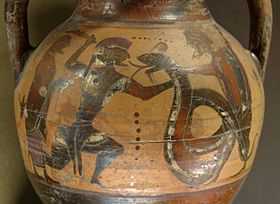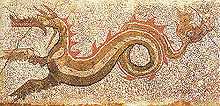Dragons in Greek mythology
| Greek Mythology |
|---|
 |
| Deities |
|
|
| Heroes and heroism |
|
| Related |
|
| Greek mythology portal |
Dragons play a great role in Greek mythology.[1] Homer describes the dragons with wings and legs.
Ladon

Ladon was the serpent-like drakon (dragon, a word more commonly used) that twined round the tree in the Garden of the Hesperides and guarded the golden apples. Ladon was also said to have as many as one hundred heads. He was overcome and possibly slain by Heracles. After a few years, the Argonauts passed by the same spot, on their chthonic return journey from Colchis at the opposite end of the world, and heard the lament of "shining" Aigle, one of the Hesperides, and viewed the still-twitching Ladon (Argonautica, book iv). The creature is associated with the constellation Draco. Ladon was given several parentages, each of which placed him at an archaic level in Greek myth: the offspring of "Ceto, joined in love with Phorcys" (Hesiod, Theogony 333) or of Typhon, who was himself serpent-like from the waist down, and Echidna (Bibliotheke 2.113; Hyginus, Preface to Fabulae) or of Gaia herself, or in her Olympian manifestation, Hera: "The Dragon which guarded the golden apples was the brother of the Nemean lion" asserted Ptolemy Hephaestion (recorded in his New History V, lost but epitomized in Photius, Myriobiblion 190).
Lernaean Hydra
The Lernaean Hydra was a dragon-like water serpent with fatally venomous breath, blood and fangs, a daughter of Typhon and Echidna. The creature was said to have anywhere between five and 100 heads, although most sources put the number somewhere between seven and nine. For each head cut off, one or two more grew back in its place. It had an immortal head which would remain alive after it was cut off. Some accounts claim that the immortal head was made of gold. It lived in a swamp near Lerna and frequently terrorized the townsfolk until it was slain by Heracles, who cut the heads off, with the help of his nephew Iolaus, who then singed the oozing stump with a blazing firebrand to prevent any new heads from growing, as the second of his Twelve Labors. Hera sent a giant crab to distract Heracles, but he simply crushed it under his foot. Hera then placed it in the heavens as the constellation Cancer. After slaying the serpent, Heracles buried the immortal head under a rock and dipped his arrows in the creature's blood to make them fatal to his enemies. In one version, the poisoned arrows would eventually prove to be the undoing of his centaur tutor Chiron, who was placed in the heavens as the constellation Centaurus.
Pytho or Python
In Greek mythology Python was the earth-dragon of Delphi, always represented in the vase-paintings and by sculptors as a serpent. Various myths represented Python as being either male or female (a drakaina).[2] Python was the chthonic enemy of Apollo, who slew it and remade its former home his own oracle, the most famous in Greece.
There are various versions of Python's birth and death at the hands of Apollo. In the earliest, the Homeric Hymn to Apollo, little detail is given about Apollo's combat with the serpent or its parentage. The version related by Hyginus [1] holds that when Zeus lay with the goddess Leto, and she was to deliver Artemis and Apollo, Hera sent Python to pursue her throughout the lands, so that she could not be delivered wherever the sun shone. Thus when the infant was grown he pursued the python, making his way straight for Mount Parnassus where the serpent dwelled, and chased it to the oracle of Gaia at Delphi, and dared to penetrate the sacred precinct and kill it with his arrows beside the rock cleft where the priestess sat on her tripod. The priestess of the oracle at Delphi became known as the Pythia, after the place-name Pytho, which was named after the rotting (πύθειν) of the serpent's corpse after it was slain.
The Colchian Dragon
(Georgian: კოლხური დრაკონი) This immense serpent, a child of Typhon and Echidna, guarded the Golden Fleece at Colchis.[3] It was said to never sleep, rest, or lower its vigilance. According to Ovid's Metamorphoses, the monster had a crest and three tongues.[4] When Jason went to retrieve the Fleece, the witch Medea put the dragon to sleep with her magic and drugs,[5] or perhaps Orpheus lulled it to sleep with his lyre. Afterwards, Medea herself had dragons pull her chariot.
The Ismenian Dragon
The Ismenian Serpent, of the spring of Ismene at Thebes, Greece, was slain by the hero Cadmus.[6] It was the offspring of Ares, who later turned the hero into a serpent.
Solar Dragons
When not driven by horses, the chariot of the Helios, the sun god, is described as being pulled by fiery draconic beings.[7] The most notable instance of this is observed in the episode in which Medea is given her grandfather's chariot, which is pulled by serpents through the sky.
See also
References
- ↑ Ingersoll,Ernest, et al., (2013). The Illustrated Book of Dragons and Dragon Lore. Chiang Mai: Cognoscenti Books. ASIN B00D959PJ0
- ↑ "Python at Theoi.com"
- ↑ "A Dictionary of Greek and Roman Biography and Mythology"
- ↑ Morford, Mark; Robert Lenardon (2003). Classical Mythology (7 ed.). New York: Oxford University Press. p. 581.
- ↑ "Colchian Dragon at Theoi.com"
- ↑ Theoi.com: Drakon Ismenios; excerpts of Greek myth in translation.
- ↑ Theoi.com on Helios
External links
| ||||||||||||||||||||||||||||||||||||||||||||||||||||||